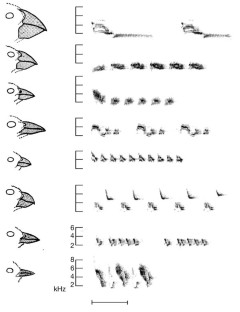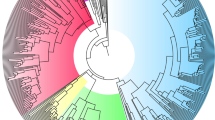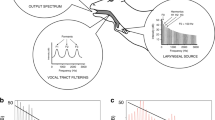Abstract
Speciation in many animal taxa is catalysed by the evolutionary diversification of mating signals1. According to classical theories of speciation, mating signals diversify, in part, as an incidental byproduct of adaptation by natural selection to divergent ecologies2,3, although empirical evidence in support of this hypothesis has been limited4,5,6. Here I show, in Darwin's finches of the Galápagos Islands, that diversification of beak morphology and body size has shaped patterns of vocal signal evolution, such that birds with large beaks and body sizes have evolved songs with comparatively low rates of syllable repetition and narrow frequency bandwidths. The converse is true for small birds. Patterns of correlated evolution among morphology and song are consistent with the hypothesis that beak morphology constrains vocal evolution, with different beak morphologies differentially limiting a bird's ability to modulate vocal tract configurations during song production. These data illustrate how morphological adaptation may drive signal evolution and reproductive isolation, and furthermore identify a possible cause for rapid speciation in Darwin's finches.
This is a preview of subscription content, access via your institution
Access options
Subscribe to this journal
Receive 51 print issues and online access
$199.00 per year
only $3.90 per issue
Buy this article
- Purchase on Springer Link
- Instant access to full article PDF
Prices may be subject to local taxes which are calculated during checkout




Similar content being viewed by others
References
West-Eberhard, M. J. Sexual selection, social competition, and speciation. Quart. Rev. Biol. 58, 155–183 ( 1983).
Dobzhansky, T. Genetics and the Origin of Species 3rd edn (Columbia Univ. Press, New York, 1951).
Mayr, E. Animal Species and Evolution (Harvard Univ. Press, Cambridge, MA, 1963).
Rice, W. R. & Hostert, E. E. Laboratory experiments on speciation: what have we learned in 40 years? Evolution 47, 1637–1653 (1993).
Schluter, D. & Nagel, L. Parallel speciation by natural selection. Am. Nat. 146, 292–301 (1995).
Rundle, H. D., Nagel, L., Boughman, J. W. & Schluter, D. Natural selection and parallel speciation in sympatric sticklebacks. Science 287, 306–308 ( 2000).
Nowicki, S. Vocal tract resonances in oscine bird sound production: evidence from birdsongs in a helium atmosphere. Nature 325, 53– 55 (1987).
Fletcher, N. H. & Tarnopolsky, A. Acoustics of the avian vocal tract. J. Acoust. Soc. Am. 105, 35–49 (1999).
Westneat, M. W., Long, J. H. Jr., Hoese, W. & Nowicki, S. Kinematics of birdsong: functional correlation of cranial movements and acoustic features in sparrows. J. Exp. Biol. 182, 147–171 (1993).
Podos, J., Sherer, J., Peters, S. & Nowicki, S. Ontogeny of vocal tract movements during song production in the song sparrow. Anim. Behav. 50, 1287–1296 ( 1995).
Hoese, W. J., Podos, J., Boetticher, N. C. & Nowicki, S. Vocal tract function in birdsong production: experimental manipulation of beak movements. J. Exp. Biol. 203, 1845– 1855 (2000).
Nowicki, S., Westneat, M. W. & Hoese, W. Birdsong: motor function and the evolution of communication. Sem. Neurosci. 4, 385– 390 (1992).
Podos, J. A performance constraint on the evolution of trilled vocalizations in a songbird family (Passeriformes: Emberizidae). Evolution 51, 537–551 (1997).
Podos, J. Motor constraints on vocal development in a songbird. Anim. Behav. 51, 1061–1070 ( 1996).
Bowman, R. I. Morphological differentiation and adaptation in the Galápagos finches. Univ. Calif. Publ. Zool. 58, 1– 302 (1961).
Bowman, R. I. in Patterns of Evolution in Galápagos Organisms (eds Bowman, R. I., Berson, M. & Leviton, A. E.) 237–537 (American Association for the Advancement of Science, Pacific Division, San Francisco, 1983).
Schluter, D., Price, T. D. & Grant, P. R. Ecological character displacement in Darwin's finches. Science 227, 1056–1059 (1985).
Gibbs, H. L. & Grant, P. R. Oscillating selection in Darwin's finches. Nature 327, 511– 513 (1987).
Grant, P. R. Ecology and Evolution of Darwin's Finches 2nd edn (Princeton Univ. Press, Princeton, 1999).
Felsenstein, J. Phylogenies and the comparative method. Am. Nat. 125 , 1–25 (1985).
Martins, E. P. COMPARE, version 4.2. Computer Programs for the Statistical Analysis of Comparative Data (Univ. Oregon, Eugene, Oregon, 1999).
Cutler, B. Anatomical Studies on the Syrinx of Darwin's Finches. Thesis, San Francisco State Univ. (1970).
Ryan, M. J. & Brenowitz, E. A. The role of body size, phylogeny, and ambient noise in the evolution of bird song. Am. Nat. 126, 87–100 (1985).
Grant, P. R. & Grant, B. R. Predicting microevolutionary responses to directional selection on heritable variation. Evolution 49, 241–251 (1995).
Grant, P. R. & Grant, B. R. Cultural inheritance of song and its role in the evolution of Darwin's finches. Evolution 50, 2471–2487 (1996).
Ratcliffe, L. M. & Grant, P. R. Species recognition in Darwin's finches (Geospiza, Gould. III. Male responses to playback of different song types, dialects and heterospecific songs. Anim. Behav. 33, 290–307 ( 1985).
Grant, P. R. & Grant, B. R. Speciation and hybridization in island birds. Phil. Trans. R. Soc. Lond. B 351, 765–772 (1996).
Mooers, A. Ø., Vamosi, S. M. & Schluter, D. Using phylogenies to test macroevolutionary hypotheses of trait evolution in cranes (Gruinae). Am. Nat. 154 , 249–259 (1999).
Petren, K., Grant, B. R. & Grant, P. R. A phylogeny of Darwin's finches based on microsatellite DNA length variation. Proc. R. Soc. Lond. Ser. B. 266 , 321–330 (1999).
Sato, A. et al. Phylogeny of Darwin's finches as revealed by mtDNA sequences. Proc. Natl Acad. Sci. USA 96, 5101– 5106 (1999).
Acknowledgements
Field work was coordinated through the Charles Darwin Research Station and the Galápagos National Park Service. I thank M. Rossi-Santos, M. Moreano, H. Vargas, H. Snell and M. Hau for assistance in the field; S. Nowicki, L. Baptista, R. Bensted-Smith, R. Bowman, P. & R. Grant, A. Hendry, W. Hoese, S. Hopp, J. Jaenike, J. Lundberg, W. Maddison, L. McDade, C. Nufio, D. Papaj, S. Patek and R. Prum for discussion and feedback; and the National Science Foundation, the Univ. Arizona Foundation, the Univ. Arizona Office of the Vice President for Research and TAME airlines for financial support.
Author information
Authors and Affiliations
Rights and permissions
About this article
Cite this article
Podos, J. Correlated evolution of morphology and vocal signal structure in Darwin's finches. Nature 409, 185–188 (2001). https://doi.org/10.1038/35051570
Received:
Accepted:
Issue Date:
DOI: https://doi.org/10.1038/35051570
This article is cited by
-
Potential social facilitation through song in bird communities
Behavioral Ecology and Sociobiology (2024)
-
Complementarity in Allen’s and Bergmann’s rules among birds
Nature Communications (2023)
-
Machine learning and statistical classification of birdsong link vocal acoustic features with phylogeny
Scientific Reports (2023)
-
Both morphological and behavioral traits predict interspecific social dominance in birds
Journal of Ornithology (2023)
-
Breeding biology of the White-throated Kingfisher Halcyon smyrnensis smyrnensis, with emphasis on color and vocalization
Journal of Ornithology (2023)
Comments
By submitting a comment you agree to abide by our Terms and Community Guidelines. If you find something abusive or that does not comply with our terms or guidelines please flag it as inappropriate.



